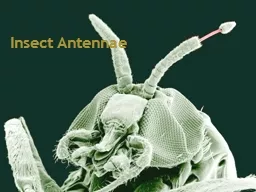

A ntennae The antennae are a pair of sense organs located near the front of an insects head capsule Although commonly called feelers the antennae are much more than just tactile receptors They are usually covered with olfactory receptors that can detect ID: 459118
Download Presentation The PPT/PDF document "I nsect" is the property of its rightful owner. Permission is granted to download and print the materials on this web site for personal, non-commercial use only, and to display it on your personal computer provided you do not modify the materials and that you retain all copyright notices contained in the materials. By downloading content from our website, you accept the terms of this agreement.
Slide1
I
nsect
A
ntennaeSlide2
The
antennae are a pair of sense organs located near the front of an insect's head capsule. Although commonly called "feelers", the antennae are much more than just tactile receptors. They are usually covered with olfactory receptors that can detect
ordor
molecules in the air (the sense of smell).
Many
insects also use their antennae as humidity sensors, to detect changes in the concentration of water
vapour.
Mosquitoes
detect sounds with their antennae, and many flies use theirs to gauge air speed while they are in flight.
Slide3
Although antennae vary widely in shape and function, all of them can be divided into three basic parts
:
scape
-- the basal segment that articulates with the head
capsule
pedicel -- the second antennal
segment.
flagellum -- all the remaining "segments" (individually called
flagellomeres
).Slide4
Types of antennaeSlide5
Filiform
antennae:
This
is the most basic form of insect antennae.
This basic structure is modified in a wide variety of ways.
This means
that a number of different types may be recognised. (Orthroptera) Slide6
Setaceous
- There are many joints. The antenna tapers gradually from the base to the tip e.g.
Cockroaches
,
Stoneflies
.Slide7
Moniliform
- The round segments make the antenna look like a string of beads e.g.
Beetles
.Slide8
Serrate
- the segments are angled on one side giving the appearance of a saw edge e.g.
Beetles
.Slide9
Pectinate
- The segments are longer on one side. This gives the appearance of a comb e.g.
Sawflies
(related to wasps) and
Beetles
.Slide10
Bipectinate
: The segments are longer on two
.
sideSlide11
Clavate
- the segments become wider towards the tip of the antenna. This may be gradual along its length, or a sudden increase and therefore mainly affecting the last few joints and giving the appearance of a club e.g.
Butterflies
and
Beetles
.Slide12
Lamellate
- the segments towards the end are flattened and plate-like. This gives the appearance of a fan e.g.
BeetlesSlide13
Plumose and
Piplumose
- the segments each have a number of fine thread-like branches. This gives the appearance of a feather e.g.
Flies
.
Slide14
Capitates:
Capitate
antennae are abruptly clubbed at the end. Ex. Butterflies.Slide15
Aristate
:
pouch-like with lateral bristle. Ex. House fliesSlide16
Geniculate
:
there
is an abrupt bend or elbow part of the way along the antenna e.g.
Ants
and
BeetleSlide17
Stylate
: having a pointed process, a
style
.
Aristate
is similar, but the process is off-centerSlide18Slide19